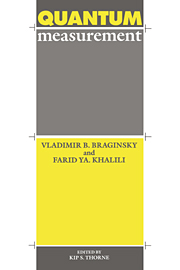Book contents
- Frontmatter
- Contents
- Dedication
- Editor's Foreword
- Notation
- Chapter I Historical introduction: photons and measurements using photons
- Chapter II The main principles of quantum mechanics
- Chapter III Indirect measurements
- Chapter IV Quantum nondemolition measurements
- Chapter V Linear measurements
- Chapter VI Continuous linear measurements
- Chapter VII Nonlinear systems for continuous measurements
- Chapter VIII Detection of classical forces
- Chapter IX Energetic quantum limitations
- Chapter X Devices for measuring small mechanical displacements
- Chapter XI Quantum nondemolition measurements of a resonator's energy
- Chapter XII Nonclassical states of electromagnetic waves as tools for quantum measurements
- Conclusion
- References
- Subject Index
Chapter III - Indirect measurements
Published online by Cambridge University Press: 15 December 2009
- Frontmatter
- Contents
- Dedication
- Editor's Foreword
- Notation
- Chapter I Historical introduction: photons and measurements using photons
- Chapter II The main principles of quantum mechanics
- Chapter III Indirect measurements
- Chapter IV Quantum nondemolition measurements
- Chapter V Linear measurements
- Chapter VI Continuous linear measurements
- Chapter VII Nonlinear systems for continuous measurements
- Chapter VIII Detection of classical forces
- Chapter IX Energetic quantum limitations
- Chapter X Devices for measuring small mechanical displacements
- Chapter XI Quantum nondemolition measurements of a resonator's energy
- Chapter XII Nonclassical states of electromagnetic waves as tools for quantum measurements
- Conclusion
- References
- Subject Index
Summary
The two main types of quantum measurements
von Neumann's postulate of the reduction of the wave function answers the question of what happens to the quantum object during the measurement. However, the reduction postulate does not answer the question of how the measuring device must be designed to realize the desired measurement. To answer this second question, one must understand the connection between the measuring device as an ordinary physical system, and the nature of the desired measurement (the quantity to be measured, the desired precision, and the choice of how the measurement is to perturb the quantum object).
The Schrödinger equation cannot tell us the connection between the design of the measuring device and the nature of the measurement, because the Schrödinger equation neither governs nor describes the process of measurement. More specifically: The evolution of the wave function as described by the Schrödinger equation has two key features: it is a reversible evolution (from the final state in principle one can always evolve back to the initial one), and it is a deterministic evolution (the final state is determined uniquely by the initial one). By contrast, the reduction of the wave function in a measurement is irreversible (once the measurement is finished and the information has been extracted from it, it is impossible to return to the pre-measurement state), and it is nondeterministic (one cannot predict, before the measurement, the post-measurement state of the measured object).
- Type
- Chapter
- Information
- Quantum Measurement , pp. 38 - 49Publisher: Cambridge University PressPrint publication year: 1992



